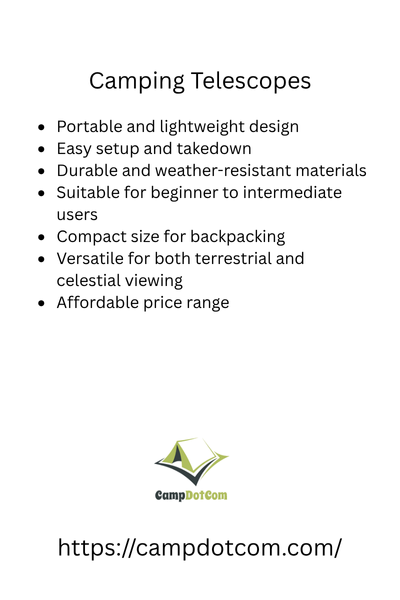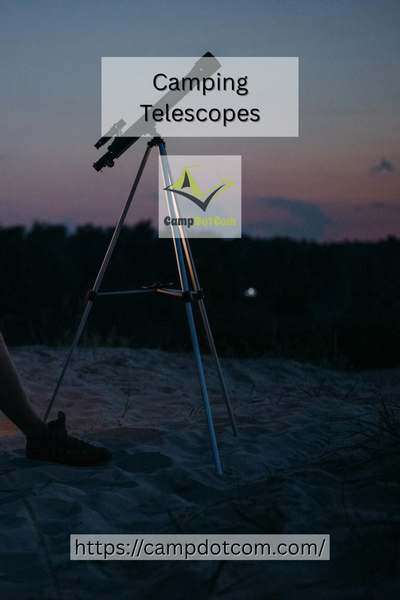Ever find yourself lying on the grass after a long day of hiking, staring up at the stars, and wishing you could see more? Well, that’s where a camping telescope comes in.
Imagine the clarity, the detail, the beauty of the night sky when you have the right tool to bring it all into focus. If you haven’t thought about it yet, it’s time to consider adding a camping telescope to your gear list.
Read More About Camping Telescope

What’s So Great About Camping Telescopes?
When you’re out in nature, far from city lights, the night sky can feel like an entirely different world. If you’ve ever been camping, you know that feeling of awe when you look up and see the Milky Way stretching across the sky.
As an Amazon Associate, I earn from qualifying purchases. Some of the links in this article are affiliate links. This means that, at zero cost to you, I will earn an affiliate commission if you click through the link and finalize a purchase.
But unless you’re a professional stargazer, it’s hard to fully appreciate what’s up there with just the naked eye. That’s where a good camping telescope makes all the difference.
I remember my first camping trip with a telescope. It was a spur-of-the-moment decision, and honestly, I didn’t think I’d use it much. I mean, it’s camping, right? How complicated could stargazing be? But once I set it up and peered through that lens, I was hooked.
I saw craters on the moon, distant planets, and constellations that looked completely different from how I had imagined. It is a whole new experience that adds a bit of magic to your night outdoors.
Types of Camping Telescopes: Which One’s Right for You?
When you’re choosing a camping telescope, it’s important to think about portability, ease of setup, and, of course, what you actually want to see. There are a few main types that are perfect for camping trips.
- Refractor Telescopes: These are the classic ones with a long, straight tube. They’re easy to use, and they’re great for beginners. They usually provide sharp, clear images, which is perfect for casual stargazing or spotting the moon and planets.
- Reflector Telescopes: These tend to be a bit bulkier but provide wider views. If you’re planning to do more detailed observing and want to see galaxies or nebulae, a reflector might be your best bet. Just be prepared for a bit more setup and maintenance.
- Catadioptric Telescopes: These are a combination of refractor and reflector designs. They’re compact and versatile, but they come with a higher price tag. Still, if you’re a serious stargazer who loves the idea of having a powerful telescope that’s easy to transport, this could be your dream tool.
More Things to Know About Camping Telescope

Personally, I love my refractor telescope for its simplicity. It’s lightweight and quick to set up, making it perfect for those spontaneous moments when the night sky demands attention. But, I can totally see the appeal of a more advanced model for those who want to take their stargazing to the next level.
Things to Look for When Buying a Camping Telescope
Okay, so you’re convinced that a camping telescope is a must-have for your next trip. But how do you choose the right one? There are a few things to keep in mind:
- Portability: You don’t want to be lugging around something heavy. Camping is all about traveling light, so look for a telescope that’s easy to pack and carry. A lightweight design makes it much easier to take along for your adventures.
- Ease of Setup: Camping is about relaxation, not complicated setups. Choose a telescope that doesn’t take forever to assemble. The easier it is to get started, the more time you’ll have to enjoy the view.
- Magnification Power: Higher magnification is great for seeing distant objects, but remember, a telescope that’s too powerful can actually make things harder to see if the image isn’t stable. A magnification of around 50x to 100x is plenty for most casual campers and beginners.
- Durability: You’re in the great outdoors, after all. Look for something that can handle a bit of rough treatment. Telescopes with sturdy tripods and weather-resistant features are your best bet.
The Best Time for Using a Camping Telescope
You might be thinking, “Okay, so I’ll bring my telescope along, but when do I actually use it?” Great question! The best time to break out your camping telescope is, of course, at night. But there are some tricks to making sure you get the most out of your stargazing experience.
For one, try to go on clear, moonless nights. The darker the sky, the more you’ll be able to see. And if you’re camping near a national park or away from the city, you’ll have a much better view of distant stars and galaxies. Trust me, it’s worth waiting for a good, clear night to really get your telescope working its magic.
A Few Tips for Stellar Stargazing
Here are some quick tips that will make using your camping telescope even more enjoyable:
- Give your eyes time to adjust to the dark. If you rush out to look through the telescope, you’ll miss the finer details. Let your eyes adapt for 10-15 minutes, and the night sky will appear brighter and clearer.
- Use a star chart or stargazing app. These tools are fantastic for helping you identify stars, planets, and constellations. They’re super helpful, especially if you’re new to the night sky.
- Practice before your trip. Familiarize yourself with how to use your telescope, so when the moment arrives, you’re not fumbling around in the dark.
Camping Telescopes A Whole New World at Your Fingertips
A camping telescope isn’t just a cool gadget to have—it’s a gateway to a whole new world. Whether you’re casually looking for constellations or diving deep into planetary details, it brings a whole new level of excitement to your camping experience.
So, the next time you pack up your camping gear, consider slipping a telescope into the mix. You won’t regret it when you’re lying back, gazing at the stars, and thinking, “Wow, I can see that!”
